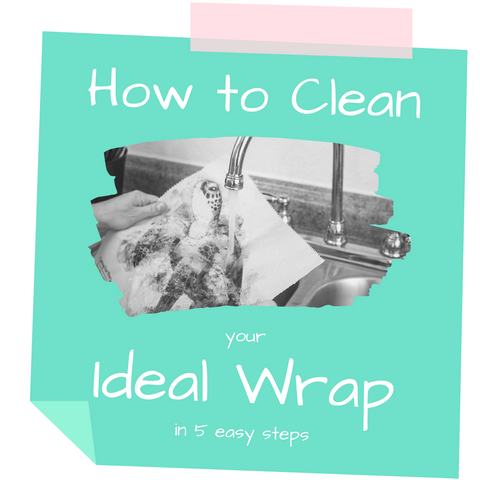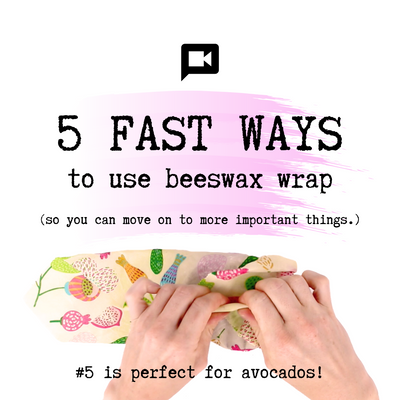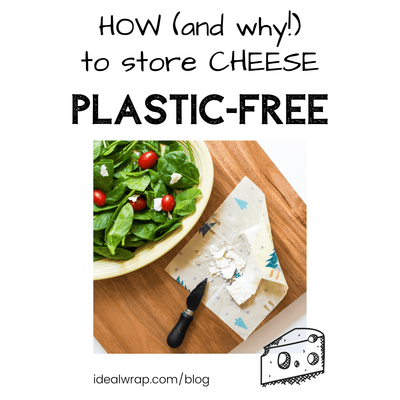How to Clean a Beeswax Food Wrap
Last week I published Ideal Wrap 101: What is a beeswax food wrap with tons of great but basic information about beeswax food wraps in general, including how to use, wash, store, and get the most out of them.
By FAR the number one question I get asked about Ideal Wrap is "How do you wash it?" So I'm going to create a quick lesson right here, right now, with just that information.

How to wash a beeswax food wrap
Ideal Wrap is very easy to clean, which is one reason it's such a totally awesome reusable kitchen item. I'm going to break the process down into 5 simple steps.
Step 1: To wash or not to wash
Because the beeswax coating on Ideal Wrap has natural antibacterial properties, you don’t need to wash your wrap after every single use. So first, assess whether it needs to be washed in the first place.
While Ideal Wrap is incredibly durable and can be washed over and over again, frequent washing increases wear and tear on your wrap. This is why I always suggest, if it's not dirty, don't wash it, but spot-clean instead.
If your wrap only contacted dry, odorless surfaces and doesn't have any stuck-on food particles or dried juices, it's probably sufficient to brush off any crumbs with your hands and fold it and put it away. If you're left with a few dirty spots but it's clean overall, spot-clean with a clean sponge using cold water.
The gentle texture of a wet sponge is usually enough to combat dried on mustard, avocado, or a little fruit juice. For stubborn mustard stains, a drop of dish detergent on your sponge will do the trick. Rinse with cold water.

Step 2: Give it a rinse
When your wrap is slightly dirty from wrapping fruits, veggies and sandwiches, give your wrap a rinse under cold water. Do not submerge your wrap in water.
The colder the water, the better it is for your wrap. Cold temperatures harden the beeswax coating, keeping it in place, so you can rinse away those dried fruit juices without needing to scrub. Use your hand to mobilize any liquids that have already dried onto the wrap.

Step 3: Lather with soap if needed
If your wrap is really dirty, that's ok! We're going to get it clean in no time.
For a larger wrap, clean your sink first so you don't have to worry about your wrap laying in the bottom of the sink. Run cold water over both sides of the wrap. Again, cold water will harden the beeswax allowing you to better clean the surface without removing any of the coating.
If there is any dried gunk (avocados love to leave bits behind), now is the time to gently scrape them off using the back of a spoon.
Next, put a couple of drops of mild dish detergent onto your wet wrap or your hands, and gently massage between your hands to create a lather, getting both sides from top to bottom - or you can target the dirty spots. Rinse well with cold water.
Step 4: Dry thoroughly
Once you've removed the gunk and the soap, lay your wrap out on a lint-free dish towel and pat dry. An old dish towel that's been washed a lot or a large tea towel both work great. I like to fold or roll the wrap inside the towel and apply light pressure to get the entire wrap dry quickly. You want to avoid letting water sit on the wrap for a long period of time.
Then simply hang the wrap to air dry - this only takes a few minutes with good air flow. I usually hang mine on the oven handle, but if you have more than one, an indoor clothesline is great.

If your wrap has a funky smell from wrapping onions, aromatic cheeses, or some broccoli you forgot about in the back of the fridge, allow the wrap to air out for a few days - I drape mine over a decorative item in my kitchen that’s out of the way. Thankfully, a soapy wash and a couple days to air out will get rid of most odors. However, if you find after these steps your wrap still smells, don't toss it yet; any smells I've encountered on my wraps have always gone away with time.

Step 5: Store properly
Once your wrap is clean and dry, fold neatly and store back in the original packaging or in a stack with all your other wraps in a clean drawer or cabinet. It's best to keep your wraps out of the way of airborne particles, since the adhesive coating will pick up dust and debris.

If stored in a cool and dry place, your wraps will last a very long time. Beeswax has an infinite shelf-life, however, when the coating starts to wear down with use, the fabric becomes exposed in tiny areas. If not kept clean from food particles and stored in a cool and dry place, the fabric can be susceptible to mold. This is why I suggest not storing in the drawer beside your dishwasher since humidity can be a wrap killer. I also don't recommend any airtight container, because if there is moisture inside and you leave the wraps for an extended period of time, they can possibly mold.
And there, my friends, is how to wash and store a beeswax wrap with the best possible outcome. I hope you found this really helpful and if you have other dirty beeswax wrap situations that weren't addressed here, please comment below (or email me!) and I'll get the answer for you!
Thanks for reading! Follow this link to purchase your Sea Turtle wraps!
You should also check out:









